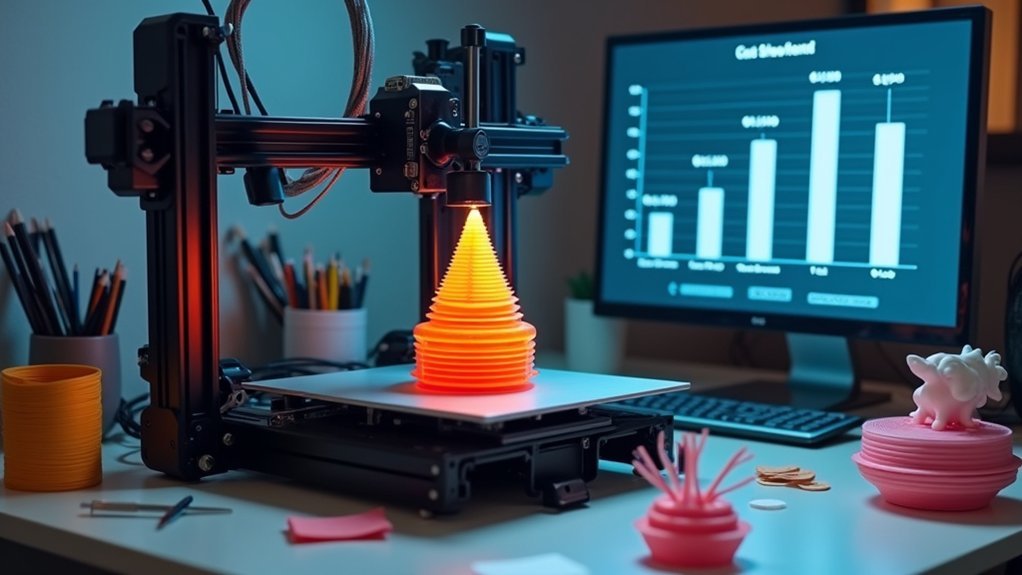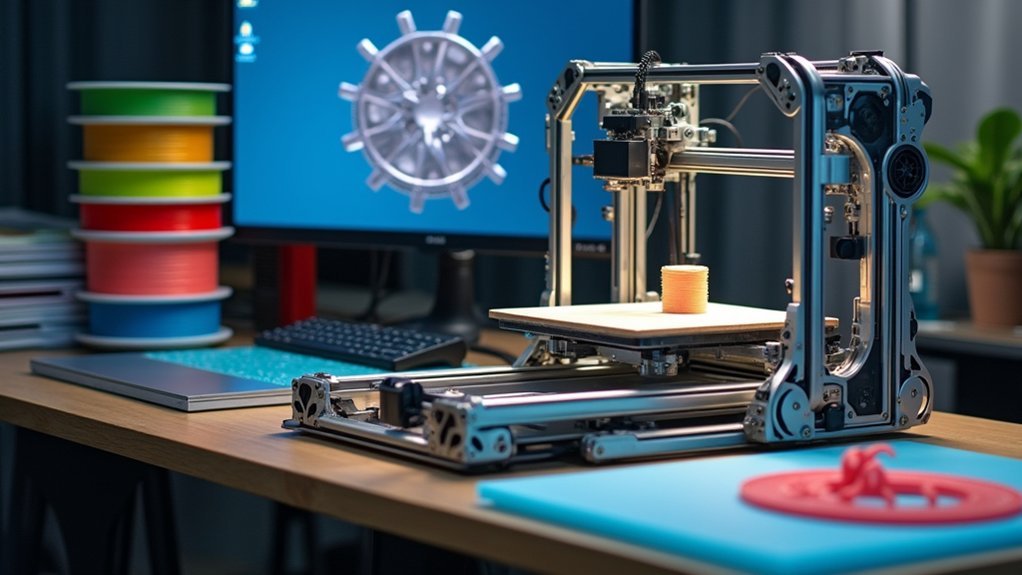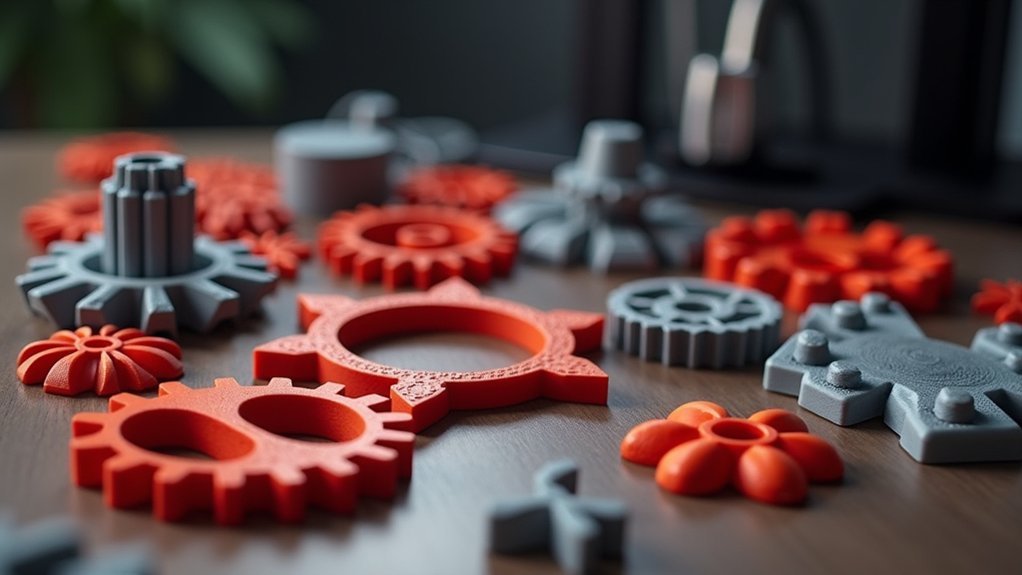You’ll typically spend $50 to $5,000 for most 3D printed prototypes, though intricate designs using premium materials can reach $20,000 or more. Your costs depend on material selection—PLA filament starts around $10-30 per kilogram while metal powders exceed $100 per kilogram—plus design complexity, prototype size, and post-processing requirements. Labor expenses range from $20-150 per hour based on technician expertise. Understanding these factors will help you optimize your prototype budget and manufacturing strategy.
Understanding the Primary Cost Drivers of 3D Printing Prototypes

When you’re planning a 3D printing project, several key factors will determine your prototype’s final cost.
Material costs represent the most significant expense, with standard PLA ranging from $10-$30 per kilogram while specialty materials command premium prices.
Design complexity directly impacts your printing costs through increased material usage and extended production time for intricate geometries requiring support structures.
Post-processing requirements add substantial expenses to your overall cost, especially when high-quality finishes are needed for support removal and surface treatments.
The prototype’s size dramatically affects material consumption and manufacturing duration.
Equipment expenses also influence your prototype cost to make, as industrial-grade SLS and MJF machines can cost $100,000 to over $700,000, affecting per-part pricing calculations.
Material Selection Impact on Prototype Pricing
Your material choice directly determines your prototype’s final cost, with polymer filaments like PLA starting around $10-30 per kilogram while metal powders can exceed $100 per kilogram.
You’ll pay based on actual material volume used, meaning complex designs requiring support structures will increase your expenses considerably.
Specialty materials command premium prices, with high-resolution SLA resins ranging from $40-200 per kilogram depending on the properties you need.
Polymer Vs Metal Costs
Material selection fundamentally drives your 3D printing prototype costs, with polymer options typically ranging from $10 to $200 per kilogram while metal powders start at $50 per kilogram and often exceed $200 for specialized alloys like titanium.
Polymer materials offer significant advantages for rapid prototyping, allowing more intricate geometries at lower costs. The complexity of design becomes more manageable with polymers since they require fewer support structures and minimal post-processing.
Production methods also impact your prototyping costs substantially. Metal printing techniques like SLM and DMLS demand expensive machinery and longer processing times compared to polymer methods like FDM.
While polymers excel for cost-effective rapid prototyping, you’ll need metal prototypes for functional testing in high-performance applications, justifying their premium pricing.
Volume-Based Material Pricing
As your prototype volume increases, material pricing structures shift dramatically in your favor through economies of scale that can reduce per-unit costs by 20-40% on larger orders.
Volume-based material pricing varies greatly across technologies—FDM filaments cost $10-30 per kilogram while SLA resins range $40-200 per kilogram. Your material selection directly impacts these savings potential.
Bulk purchasing becomes essential when you’re producing multiple prototype iterations.
SLS and MJF processes using nylon or metal powders typically carry higher baseline costs, but volume discounts can offset these expenses considerably.
You’ll find that higher-quality materials command premium prices initially, yet bulk orders help normalize these costs across your total project costs.
Understanding this pricing dynamic helps you budget more effectively for prototype development campaigns.
Specialty Material Premiums
Three key factors drive specialty material premiums in 3D printing: performance requirements, chemical composition, and processing complexity.
Your material selection directly impacts prototype costs, with advanced materials like Polyetherimide (PEI) costing $100+ per kilogram versus standard ABS at $30.
Consider these specialty materials pricing factors:
- High-performance polymers – Premium grades for demanding applications
- Composite materials – Enhanced properties command hundreds per kilogram
- Metal powders – Specialized alloys greatly exceed nylon’s $50/kg baseline
- Processing requirements – Complex production methods increase overall expenses
When you’re selecting specialty materials, remember that material procurement costs extend beyond initial pricing.
Advanced materials often require specialized equipment, modified production methods, and additional post-processing.
Your prototype’s complexity and performance demands will determine whether these premiums justify the enhanced capabilities you’ll achieve.
How Design Complexity Affects Manufacturing Expenses
When you’re designing prototypes for 3D printing, the complexity of your design directly impacts your manufacturing expenses.
Simple designs with minimal overhangs and uniform cross-sections require fewer materials and less printing time, while complex geometries demand extensive support structures that increase both material costs and post-processing labor.
You’ll find that intricate designs not only take longer to print but also require more hands-on work to remove supports and finish surfaces, markedly driving up your overall prototype costs.
Simple Vs Complex Designs
Design complexity serves as one of the most notable cost drivers in 3D printing prototypes, creating a substantial gap between simple and intricate models.
Simple designs typically cost $30-$5,000, while intricate designs can reach $20,000 or more due to increased material usage and manufacturing expenses.
Complex prototypes require extensive support structures, dramatically increasing your overall cost through:
- Higher material consumption for structural supports
- Extended production timeframes for detailed geometries
- Additional post-processing labor to remove supports
- Increased risk of printing failures requiring reprints
You’ll find that larger volumes combined with complex features demand considerably more resources.
However, implementing design optimization strategies like hollowing parts or minimizing support requirements can substantially reduce your manufacturing expenses while maintaining prototype functionality.
Support Structure Requirements
Support structures represent the hidden cost multiplier that can transform an affordable prototype into an expensive undertaking.
When you’re dealing with complex designs featuring overhangs or intricate details, you’ll need these temporary scaffolds that increase material usage by 20-30% and extend printing time considerably.
Your post-processing costs escalate as you’ll spend additional labor hours carefully removing these structures without damaging your prototype.
Complex designs often require specialized techniques like SLA or SLS, which cost more than standard FDM printing.
However, you can achieve substantial cost savings through strategic design optimization.
Post-Processing Time Impact
Beyond the initial printing phase, complex geometries demand extensive post-processing work that can dramatically inflate your prototype costs.
When you’re dealing with intricate designs, you’ll face substantial additional expenses that can increase total production costs by 20-50% compared to simpler parts.
Here’s how post-processing time impacts your budget:
- Support removal – Complex designs require more material usage for supports, extending removal time.
- Specialized finishing work – Intricate geometries need advanced techniques like precision sanding or chemical treatments.
- Multiple processing stages – Detailed parts often require sequential steps including curing, painting, and assembly.
- Quality control – Complex features demand thorough inspection and potential rework.
Smart design optimization can minimize these time-consuming steps, helping you control expenses while maintaining prototype quality.
Comparing Costs Across Different 3D Printing Technologies
When you’re evaluating 3D printing technologies for prototyping, the cost differences between methods can considerably impact your project budget.
FDM offers the most affordable entry point, with materials costing $10-30 per kilogram, making it perfect for simple design iterations.
However, if you need high-resolution prototyping, SLA technology starts at $10,000 with materials ranging $40-200 per kilogram.
For complex geometries requiring Selective Laser Sintering, you’ll face costs between $100,000-700,000 for equipment, plus materials exceeding $50 per kilogram.
Multi Jet Fusion provides similar capabilities with lower initial investments of $100,000-250,000, though material costs remain high.
Your design complexity directly influences which technology delivers the best value for your prototyping needs.
Labor and Operational Expenses in Prototype Development

You’ll need to factor in skilled labor hourly rates when calculating your prototype development costs, as these can vary considerably based on worker experience and project complexity.
The post-processing requirements for your prototypes will demand additional labor time that extends beyond the initial printing phase.
These time investments for tasks like support removal, sanding, and finishing can greatly impact your overall budget projections.
Skilled Labor Hourly Rates
Three primary factors determine skilled labor hourly rates in 3D printing prototype development: the technician’s experience level, specialized expertise, and geographic location.
You’ll encounter rates ranging from $20 to $150 per hour, with complexity directly impacting your overall expenses.
Skilled personnel costs vary based on:
- Entry-level technicians – $20-40/hour for basic operations
- Experienced operators – $50-80/hour for complex designs
- Expert engineers – $100-150/hour for specialized prototyping
- Post-processing specialists – $40-70/hour for finishing work
Labor costs can escalate during iterative phases when you’re making multiple revisions.
However, implementing an efficient workflow with experienced teams notably reduces prototype development time.
Smart operational expenses management means balancing expertise levels with project requirements to optimize your investment.
Post-Processing Time Requirements
Although 3D printing completes your prototype’s basic structure, post-processing demands substantial additional time that directly impacts your project’s labor and operational expenses.
Your post-processing time requirements vary greatly based on printing technology choices. SLA prototypes typically need extensive resin cleaning and curing, while FDM parts require support removal and surface finishing.
These tasks add several hours to prototype development timelines, increasing labor costs between $20-$100 hourly depending on complexity. Extended post-processing also elevates operational expenses through increased electricity consumption and equipment maintenance.
You’ll minimize total cost through strategic design optimization that reduces finishing requirements. Consider your printing technology’s post-processing demands during project planning to accurately budget labor and operational expenses for successful prototype development.
Equipment Investment and Maintenance Considerations
When considering 3D printing for prototyping, the equipment investment represents one of your most significant upfront expenses, with costs varying dramatically based on the 3D printing technology you choose.
Your initial investment depends on the specific technology:
- FFF printers start around $5,000 for industrial models.
- SLA printers range from $10,000 to over $50,000 based on capabilities.
- SLS printers cost between $100,000 and $700,000 for advanced equipment.
- Energy-efficient printers reduce long-term operational costs through lower electricity consumption.
Beyond equipment investment, you’ll face ongoing maintenance requirements that impact your total cost of ownership.
Regular upkeep guarantees prime performance but creates potential downtime and repair expenses.
Operational costs include electricity consumption during long print times, making energy-efficient printers a smart long-term investment for managing ongoing expenses.
Post-Processing Requirements and Associated Costs

Post-processing requirements extend your investment beyond the initial equipment and material costs, often adding 20% to 50% to your total prototype expenses.
You’ll encounter various tasks like support removal, sanding, painting, and curing that increase labor costs and project timelines. The complexity of your prototype directly impacts these expenses, with high-quality finishes potentially costing hundreds to thousands of dollars in specialized industries.
Your choice of printing technology greatly influences post-processing needs. SLS and MJF technologies require less finishing work compared to FDM, where extensive support structures demand more cleanup.
SLS and MJF printing technologies significantly reduce post-processing labor compared to FDM’s extensive support structure cleanup requirements.
You can minimize overall costs by implementing design for manufacturability principles early. Reducing reliance on support structures and optimizing your initial design helps control post-processing expenses while maintaining prototype quality.
Volume and Size Effects on Per-Unit Pricing
Because prototype dimensions directly correlate with material consumption, you’ll find that doubling your part’s size can quadruple your costs due to volume calculations.
Your per unit cost decreases considerably when you increase production volume, thanks to economies of scale.
Here’s how size and complexity affect your pricing:
- Simple prototypes cost $50-$500, while complex designs can reach thousands.
- Support structures add substantial expenses for larger models.
- Material usage scales exponentially with size increases.
- Production volume reduces cost per unit through economies of scale.
You can dramatically lower expenses by optimizing the design to minimize dimensions and complexity.
Complex designs requiring extensive support structures will increase your per unit cost, especially at larger scales.
Focus on reducing material consumption through smart design choices.
In-House Vs Outsourced Prototype Manufacturing Costs
After optimizing your prototype design for cost efficiency, you’ll need to decide whether to invest in in-house 3D printing equipment or outsource production to specialized service bureaus.
In-house manufacturing requires substantial upfront investment, with industrial printers costing $5,000 to $700,000 depending on technology. You’ll also face ongoing costs including electricity, maintenance, and labor for post-processing.
Outsourcing typically offers better value for low-volume prototype production, as service bureaus leverage economies of scale without requiring capital investment. Electronic prototypes range from $10,000 to $50,000 when outsourced.
Choose in-house production for high-volume projects needing frequent design changes, while outsourcing provides flexibility and lower costs during initial prototyping phases.
Strategies for Reducing 3D Printing Prototype Expenses
While 3D printing offers rapid prototyping capabilities, smart cost management strategies can drastically reduce your project expenses without compromising prototype quality.
These design tips and prototyping methods help optimize your budget:
Smart design choices and strategic prototyping approaches can significantly optimize your 3D printing budget while preserving quality.
- Simplify Your Design – Use gradual shifts and minimize complexities to reduce material usage and printing time considerably.
- Choose Cost-Effective Materials – Select alternative materials offering similar properties while maintaining quality standards.
- Skip Unnecessary Post-Processing – Eliminate elaborate finishing steps for proof-of-concept prototypes, eliminating the need for costly refinements.
- Order Smart Batches – Start with small prototype runs to validate designs before committing to larger quantities.
When considering factors like equipment investment, use a Cost Calculator to compare in-house versus outsourcing options.
This approach helps reduce the cost efficiently while maintaining project momentum.
Calculating Total Cost of Ownership for Prototype Projects
Beyond implementing cost-reduction strategies, you need to understand the complete financial picture of your prototype projects through total cost of ownership calculations. This thorough analysis encompasses initial equipment costs ranging from $5,000 for FDM printers to $700,000 for SLS machines, material costs like nylon starting at $50 per kilogram, and skilled workers’ wages for post-processing activities.
| Cost Category | Low-End Range | High-End Range |
|---|---|---|
| Equipment | $5,000 (FDM) | $700,000 (SLS) |
| Materials | $50/kg (Nylon) | Varies by type |
| Labor/Operations | Hourly wages | Maintenance costs |
You’ll need to factor in operational expenses including electricity consumption and regular maintenance. Amortize hardware costs over the printer’s lifespan and production volume to determine accurate cost-per-part calculations for informed decision-making.
Frequently Asked Questions
How Much Does a 3D Printing Prototype Cost?
You’ll pay $30 to $5,000 for simple 3D printed prototypes, while complex mechanical ones cost $1,500 to $20,000. Electronics prototypes run higher at $10,000 to $50,000 due to specialized components.
How Much Should a Prototype Cost?
You should budget between $30-$5,000 for simple prototypes, while complex ones can cost $1,500-$20,000. Electronics prototypes range $10,000-$50,000. Always include contingency funds for unexpected changes and overruns.
What Is Prototyping in 3D Printing?
You’ll create physical models of your designs using 3D printing technology to test form, fit, and function before mass production. This iterative process lets you refine designs quickly and reduce development costs.
What Is the Cost of 3D Printing Building?
You’ll spend between $50 to several thousand dollars for 3D printed building prototypes. Simple models cost $30-$5,000, while complex mechanical prototypes range $1,500-$20,000, depending on size, materials, and finishing requirements.





Leave a Reply